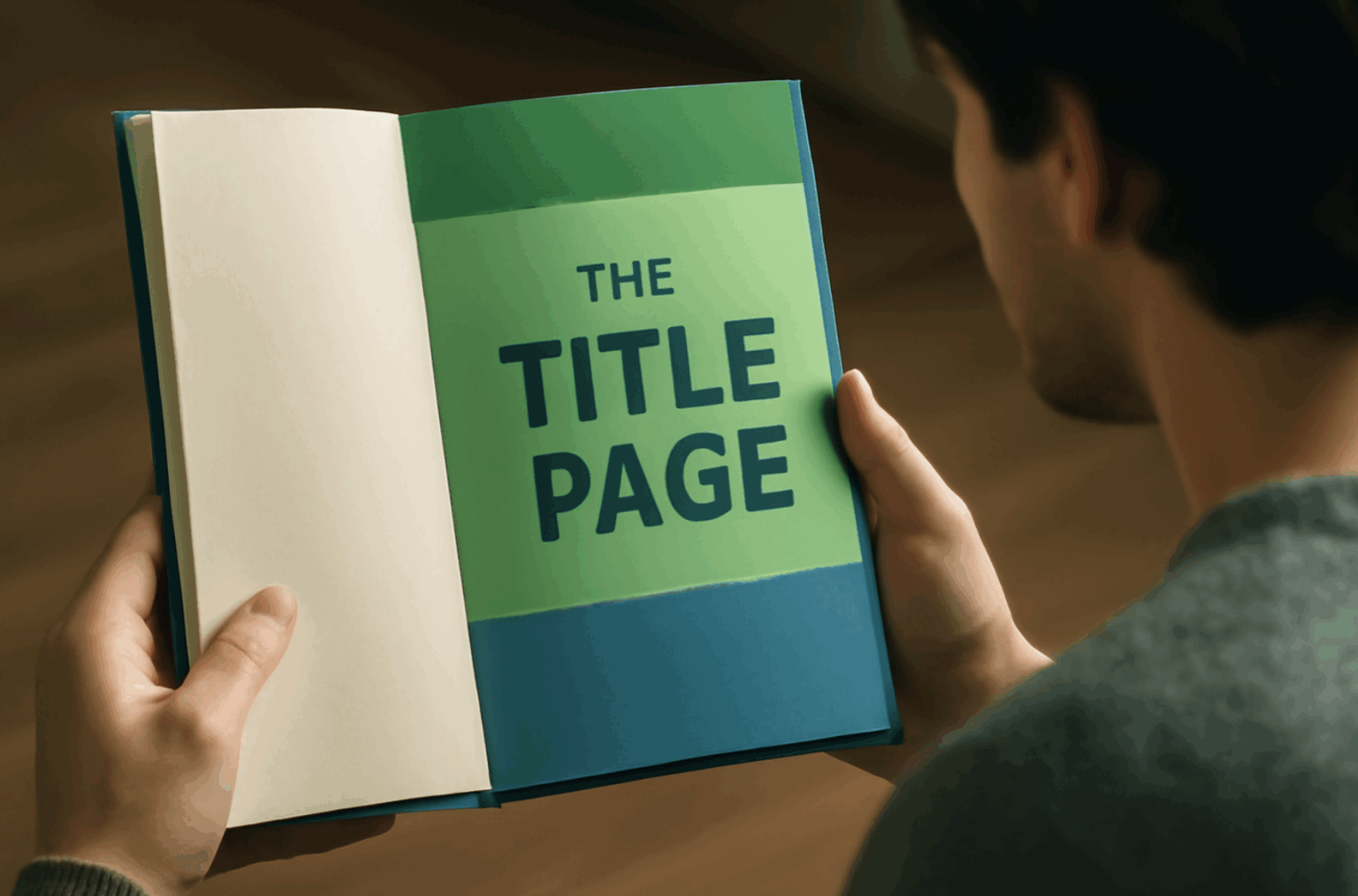After carefully choosing the perfect title for your book, it’s time to move on to formatting and the publication process. The title page is the first element that introduces your work to the reader, setting the stage for everything that follows.
Whether you’re working on a book, writing an essay, or adhering to APA guidelines, crafting an effective title page is essential to making a strong first impression. In this guide, we’ll walk through the key steps to help you format your title page correctly, ensuring it aligns with your work’s tone and purpose while giving your readers a polished and professional introduction to your content.
The Purpose of a Title Page
While it may seem like a small detail, the title page plays a crucial role: it’s the first thing your reader sees, setting the stage for what’s to come. A title page provides vital information, such as the title of your work, the author’s name, and other relevant details. It’s your document’s “business card”—clear, professional, and free from distractions.
The title page in a book serves a practical purpose beyond what’s seen on the cover. While the cover includes the title, the title page is essential for proper referencing and cataloging. It helps libraries and academic sources accurately cite and organize the book, ensuring it’s easily accessible for research and citation purposes.
The main elements of a title page typically include:
- The Title: This is the focal point, letting readers know what your document is about. It should be clear, concise, and engaging.
- Your Name: Always credit yourself as the author. For books, this typically follows the title; for essays, it goes beneath it.
- Other Relevant Information: For essays, this might include the course name, instructor’s name, and submission date. For books, you may add publisher details, copyright information, and the publication year.
A well-organized title page contributes to a professional image, helping set the tone for your entire document. But let’s explore how title pages can differ depending on the format.
Below, we outline the distinct title page formats for books, essays, and APA style, along with other notable examples.
What is the Title Page of a Book?
The title page of your book is a simple yet essential component of your work. While it may not be as eye-catching as a cover design, it plays a critical role in establishing the professionalism and credibility of your book. This page serves as the first point of contact for readers, offering a formal introduction to your work.
Beyond its basic function of presenting your title, the title page is important for legal and organizational purposes. It provides essential details like the book’s title, the author’s name, and copyright information. For authors, this is also the place to consider trademarking your book title if it’s unique and you want to protect your intellectual property. A title page may seem like a small detail, but it helps set the stage for the reader’s experience while ensuring your work is properly attributed and legally protected.
Here’s what typically makes up a book title page:
- The Title of Your Book – This is the heart of the title page. Your book’s title should be bold, clear, and encapsulate the essence of your work. Make sure it’s easy to read and memorable, but also reflective of the story you’re about to tell.
- Author’s Name – Yes, this is where you take credit! Your name usually follows the title, and it should be styled in a way that matches the book’s overall aesthetic. It’s important that this stands out enough to be noticed but doesn’t overpower the title itself.
- Publisher’s Name – If your book is published traditionally, the publisher’s name will be at the bottom. If you’re self-publishing, you’ll likely list your imprint or publishing name here instead.
- Copyright Information – Often placed at the bottom, this includes the copyright symbol, your name, and the year of publication.
A book title page is your opportunity to set the mood. Whether it’s a thrilling mystery or a heartfelt romance, this page should immediately let your reader know what to expect. Unlike academic papers, there’s room for creativity—just keep it professional and true to the vibe of your book. Think of it as your book’s first impression, making sure it’s both informative and captivating.
What is a Title Page in an Essay?
Ah, the essay title page—where academic formality meets practicality. Whether you’re working on a research paper for class, a formal report, or even an essay that will eventually land in a pile of similar-looking documents, your title page serves as the opening act to your academic masterpiece. But unlike a book title page, this one’s a bit more businesslike, setting the tone for the seriousness (or the stress!) to come.
So, what goes into an essay title page? It’s all about the basics. You want to provide just enough information so your professor knows exactly what they’re looking at without overwhelming them with extra details. Here’s what you’ll typically need:
- The Title of Your Essay – Of course, this is the star of the show. Your essay title should clearly reflect the topic and tone of your work. Keep it specific, concise, and professional. No room for puns or flair here (unless, of course, you’re writing a humor piece—then, go for it!).
- Your Name – Yes, your name makes another appearance! This one’s usually placed below the title and should be simple and clean.
- Instructor’s Name – Now we’re getting into the academic stuff. This is where your professor’s name goes, so they know who gets the credit for reading your work.
- Course Name/Number – The course you’re writing for should follow right under the instructor’s name. This helps keep things organized, especially if your professor is grading papers for multiple classes.
- Submission Date – Finally, the date you submit your essay. This may seem minor, but it’s essential for keeping things organized, especially if you’re handing in multiple drafts or working on deadlines.
In terms of formatting, you’ll want to stick to some specific guidelines to keep things looking sharp. Typically, you’ll use a readable font like Times New Roman (12-point), double-spaced lines, and centered text on the page. Margins should be 1 inch all around. It might sound picky, but trust us, these small details matter when it comes to academic formatting.
And remember, unlike a book title page that might have room for some flair or a designer touch, your essay title page should stick to a clean, simple, no-nonsense look. Think of it as a professional handshake—you want to come across as serious and ready to do business.
What is a Title Page in APA Format?
Now, let’s step into the world of APA, where order, structure, and precision reign supreme. If you’ve ever written a research paper or an academic article, chances are you’ve had to deal with the infamous APA format. And when it comes to title pages in APA style, it’s all about consistency and following the guidelines to the letter. This is where formality meets function, and, trust us, the small details really do matter.
So, what exactly goes on an APA title page? Let’s break it down:
- The Title of Your Paper – Just like in other formats, the title is the first thing people will see. In APA, the title should be concise yet descriptive of your paper’s content. Don’t get too creative here—APA is all about clarity and focus. The title should be in bold and centered at the top of the page, a little below the header.
- The Author’s Name – This one’s pretty straightforward. After the title, list your full name (no pen names here, folks). The author’s name should be centered, right below the title.
- Institutional Affiliation – If you’re a student, this is where the name of your school or university goes. It shows who you’re representing in the academic world. This too should be centered, just under your name.
- Page Number and Running Head – Okay, now here’s where things get specific. On the APA title page, you need a running head (that’s a short version of your title) in the top left corner. It’s followed by the page number, which is aligned to the top right. And yes, we’re talking about an actual page number on the first page of your paper—APA likes to keep things numbered from the start!
- Additional Notes – In some cases, like with certain professional papers or student work, the APA title page might also include things like the author’s note or a course number, depending on the requirements. But for most standard assignments, this is the main info you’ll need.
As for the look? APA title pages come with their own set of formatting rules that keep things clean and standardized. The font should be Times New Roman, 12-point, with 1-inch margins on all sides, and everything should be double-spaced. The title should be in the upper half of the page, with the author’s name and institutional affiliation placed directly below.
The goal with an APA title page is clarity, consistency, and professionalism. It’s the first piece of your paper that your professor will see, and we promise they’ll appreciate the effort you put into following these precise guidelines.
Now, if you’re thinking, “Well, this sounds a lot like the essay title page,” you’re not wrong—there are similarities. But don’t worry, we’re about to show you how these title pages differ across formats. Spoiler: it’s not just about what you put on the page, it’s about how it’s all arranged and presented.
Key Differences in Title Pages Across Formats
Alright, by now you’ve got a solid understanding of what goes on a title page for books, essays, and papers in APA format. But wait—there’s more! While they might all serve the same basic purpose of introducing your work, title pages vary quite a bit depending on the format. And it’s not just about what gets included; it’s about how it’s presented.
Let’s break it down and compare these title pages to see where the key differences lie:
The Book Title Page:
- What it includes: The title of the book, the author’s name, the publisher, and copyright info (if applicable).
- Style: Clean, simple, and professional, but with a touch of personality. The title page should reflect the tone of the book—whether that’s elegant, bold, or creative. Books may have more freedom in design choices, like fonts and placement, depending on the genre.
- Format: Generally centered, with ample space around the text. The font is often larger and bolder than in other formats.
The Essay Title Page:
- What it includes: The title of your essay, your name, instructor’s name, course name/number, and submission date.
- Style: Straightforward, no-nonsense, and functional. This title page is all about the basics—just the essential info to get things started.
- Format: Typically centered with no fancy flourishes. The font is standard (Times New Roman, 12-point), and everything is double-spaced with 1-inch margins. No distractions here!
The APA Title Page:
- What it includes: The title of your paper, author’s name, institutional affiliation, page number, and running head (that short, all-caps version of your title).
- Style: Highly structured, clean, and precise. APA format is all about uniformity, so expect to follow a strict set of rules for font size, margins, and spacing.
- Format: It’s pretty much a mix of the essay title page and the book title page when it comes to layout. Everything is centered, but with the addition of the running head and page number in the header, the presentation is more formal and standardized.
Other Title Page Formats
Depending on the context and purpose of your work, different title page formats may be required. Whether you’re preparing an academic submission, submitting a business report, or working on a dissertation, each of these formats serves a unique function tailored to specific reader expectations. By exploring these variations, you’ll gain a better understanding of the different title page types you may come across in various professional and academic settings.
MLA Title Page
- What it includes: In most cases, the MLA (Modern Language Association) format doesn’t require a title page, but it’s sometimes needed for specific assignments or publications. If you do need one, it includes the title of the paper, your name, your instructor’s name, the course name, and the date.
- Style: Simple and academic, just like the essay title page, but with a few specific MLA requirements. The title is centered, and the rest of the information appears near the top left of the page.
- Key Difference: The MLA title page typically includes less formalized formatting rules compared to APA. For example, MLA doesn’t have a running head or page numbers on the title page.
Chicago/Turabian Title Page
- What it includes: Similar to the APA format, Chicago and Turabian styles require the title, author’s name, and publication details. However, the format is a bit more flexible. In Turabian, the title page often includes the title, your name, and the course/instructor information (just like an essay).
- Style: Formal but flexible. Chicago style title pages allow for more creative choices in terms of design, but they still adhere to strict spacing and formatting guidelines.
- Key Difference: Chicago style allows for more customization, particularly when it comes to things like adding subtitles or determining the placement of your name and the title.
Business Report Title Page
- What it includes: In business reports, the title page will typically include the title of the report, the name of the company, the date, and possibly the name of the person or department submitting it.
- Style: Clean, straightforward, and professional. Business reports are all about clarity and organization, so the title page will be simple, focusing on providing key information quickly.
- Key Difference: Unlike books or essays, business reports might also include additional info like the purpose of the report, or a “Confidential” label if necessary.
Dissertation/Thesis Title Page
- What it includes: A dissertation or thesis title page will generally have the title of the thesis, the author’s name, the degree being awarded, the institution, and the date of submission.
- Style: Formal, academic, and often quite structured. Depending on the institution, there may be specific formatting requirements for this type of title page, including logos or formatting guidelines.
- Key Difference: These title pages often follow strict institutional guidelines and are more detailed than a typical essay or research paper title page. They may also include approval signatures or other relevant details specific to the submission process.
Journal Article Title Page
- What it includes: The title of the article, author(s), their affiliations, and sometimes a brief abstract.
- Style: Academic but very professional. The journal title page often includes more detailed author information, such as their institutional affiliations, and may also include acknowledgments or notes on funding sources.
- Key Difference: Journal articles often require more specific information about authors and affiliations, especially if the work is being submitted for publication.
Final Tips for Crafting the Perfect Title Page
Before we wrap up, here are a few last-minute tips to make sure your title page is truly up to snuff:
Follow the Format – As we’ve mentioned, each format has its own rules, and they’re not optional. Double-check your guidelines to ensure you’re meeting the exact requirements. Whether you’re using APA, MLA, or any other style, consistency is key.
Keep It Simple – Your title page is not the place to get fancy with fonts or design. Stick to easy-to-read fonts (Times New Roman, 12-point) and make sure your layout is clean and well-spaced.
Be Clear and Concise – Make sure your title is clear and accurately represents the content of your paper, book, or report. It’s not just about sounding good; it’s about being informative and precise.
Proofread – Yes, your title page matters that much. Typos or formatting errors here are a surefire way to start off on the wrong foot. A quick proofread can save you from some embarrassing mistakes.
Pay Attention to Margins and Spacing – It may sound minor, but proper margins (usually 1 inch) and consistent formatting and spacing are essential for a neat, professional title page. Even a small inconsistency can make your work look sloppy.
Perfecting Your Title Page for a Strong First Impression
And there you have it! While the title page might seem like a small detail, it’s actually a crucial part of presenting your work professionally. Whether you’re preparing a book for publication, submitting an essay for a class, or formatting a research paper in APA style, your title page is the first thing your readers will see, and it sets the tone for everything that follows.
By following the formatting guidelines specific to your document type—whether it’s a book, essay, APA paper, or business report—you can make sure your title page makes a stellar first impression. So, take the time to get it right. After all, the title page may only be one page, but it can leave a lasting impact!
Now that you know the ins and outs of title pages, go ahead and give your work that polished, professional start it deserves. You’ve got this!
FAQs – What is a Title Page?
Q1: What does a title page look like in a book?
In a book, the title page is a formal, clean layout that introduces the title and author. The title of the book is the central focus, typically in a bold, large font. Below that, the author’s name is displayed, often in a smaller font. If published traditionally, the publisher’s name appears at the bottom, and additional elements like copyright info or year of publication may be included at the very bottom of the page.
Q2: How do you properly title a page?
To properly title a page, make sure that the title clearly reflects the content or theme of your book or document. The title should be concise, engaging, and easy to read. The placement of the title varies depending on the format:
- For books: The title is usually centered at the top of the page.
- For essays or academic papers: The title is typically centered in the middle of the page with your name and other details placed below.
Q3: What is the primary purpose of a title page?
The primary purpose of a title page is to provide essential information about your work, such as the title, author, and sometimes additional details like the course or publisher. It sets the tone for the rest of the document and makes a professional first impression. A well-designed title page helps readers easily identify the work and its creator while establishing a sense of credibility and organization.
Q4: What does the title page tell you?
The title page tells the reader what the work is, who wrote it, and in some cases, when and by whom it was published. For academic papers, it can also give the reader context about the course or assignment. In a book, the title page serves as an introduction to the content, offering information about the author and publisher, and setting the stage for the reading experience.
Q5: Do you need a title page for an assignment?
Yes, a title page is often required for academic assignments. It helps organize your work and provides your instructor with important information upfront. Typically, a title page for an assignment will include the title of the paper, your name, the instructor’s name, the course name/number, and the submission date. Always check the assignment guidelines to confirm if a title page is needed.
Q6: What is the difference between MLA and APA title pages?
The main difference between MLA and APA title pages lies in the formatting:
- MLA: The title page is usually not required for MLA style (unless specified by the instructor). Instead, the title, your name, instructor’s name, and course details appear on the first page, aligned in the upper left corner.
- APA: An APA title page is required and should include the title of the paper, the author’s name, and institutional affiliation. For research papers, the page also includes a running head and page number in the header.







